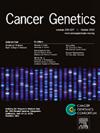False positive NUP98 fluorescence in situ hybridization rearrangements in B-acute lymphoblastic leukemia
IF 2.1
4区 医学
Q4 GENETICS & HEREDITY
引用次数: 0
Abstract
Gene fusions involving NUP98 have been reported in several hematologic malignancies yet have been very rarely reported in B-acute lymphoblastic leukemia (B-ALL). Two cases of B-ALL for which chromosome banding analysis (CBA) and fluorescence in situ hybridization (FISH) suggested apparent NUP98 rearrangements were further investigated with next-generation sequencing-based methodologies to verify the findings obtained with traditional cytogenetic methodologies. In the first case, CBA revealed a hyperdiploid karyotype with multiple structural abnormalities including additional material of unknown origin at 11p15; subsequent break-apart probe (BAP) FISH for NUP98 demonstrated 2 intact fusion signals and a single separate 5′NUP98 signal. However, whole-genome sequencing found no evidence of a NUP98 gene fusion. The results obtained with conventional cytogenetic methodologies were in fact attributable to structural variants (SV) with breakpoints not within NUP98 but within the 5′NUP98 BAP probe-binding sequence. In the second case, CBA revealed several structural and numeric abnormalities including a complex translocation between chromosomes 11 (at 11p15.4) and 19 (at 19p13.3) and an insertion of unknown material at 11p15.4. BAP FISH demonstrated a typical FISH signal pattern consistent with an apparent NUP98 rearrangement. However, no evidence of a NUP98 fusion was found on RNA sequencing. In conclusion, the two cases thus presented with clinical false positive NUP98 rearrangements by FISH. In the clinical laboratory, SVs in the vicinity of genes involved in recurrent rearrangements in hematologic malignancies may result in misleading results with conventional chromosome methodologies. This may preclude an accurate definition of the genetic attributes of malignancies with ensuing impacts on risk stratification and management. Higher-resolution testing methodologies such as whole-genome sequencing and RNA sequencing may be helpful in resolving unexpected results with conventional chromosome methodologies and enhancing the accuracy of genetic characterization of hematological malignancies in the clinical laboratory.
b急性淋巴细胞白血病NUP98荧光原位杂交重排假阳性。
涉及NUP98的基因融合已在几种血液恶性肿瘤中报道,但在b急性淋巴细胞白血病(B-ALL)中很少报道。2例B-ALL患者的染色体显带分析(CBA)和荧光原位杂交(FISH)提示存在明显的NUP98重排,采用基于下一代测序的方法进一步研究,以验证传统细胞遗传学方法得到的结果。在第一个病例中,CBA显示了一个具有多种结构异常的超二倍体核型,包括11p15处未知来源的额外物质;NUP98的后续分离探针(BAP) FISH显示了2个完整的融合信号和一个单独的5'NUP98信号。然而,全基因组测序没有发现NUP98基因融合的证据。使用传统细胞遗传学方法获得的结果实际上可归因于结构变异(SV),其断点不在NUP98内,而是在5'NUP98 BAP探针结合序列内。在第二个病例中,CBA发现了一些结构和数字异常,包括11号染色体(11p15.4)和19号染色体(19p13.3)之间的复杂易位,以及11p15.4上未知物质的插入。BAP FISH表现出典型的FISH信号模式,与明显的NUP98重排一致。然而,在RNA测序中没有发现NUP98融合的证据。综上所述,这两例患者在FISH检测中表现为临床假阳性NUP98重排。在临床实验室,SVs在血液恶性肿瘤中参与复发性重排的基因附近可能导致传统染色体方法的误导性结果。这可能会妨碍对恶性肿瘤遗传属性的准确定义,从而影响风险分层和管理。更高分辨率的检测方法,如全基因组测序和RNA测序,可能有助于解决传统染色体方法的意外结果,并提高临床实验室血液系统恶性肿瘤遗传特征的准确性。
本文章由计算机程序翻译,如有差异,请以英文原文为准。
求助全文
约1分钟内获得全文
求助全文
来源期刊

Cancer Genetics
ONCOLOGY-GENETICS & HEREDITY
CiteScore
3.20
自引率
5.30%
发文量
167
审稿时长
27 days
期刊介绍:
The aim of Cancer Genetics is to publish high quality scientific papers on the cellular, genetic and molecular aspects of cancer, including cancer predisposition and clinical diagnostic applications. Specific areas of interest include descriptions of new chromosomal, molecular or epigenetic alterations in benign and malignant diseases; novel laboratory approaches for identification and characterization of chromosomal rearrangements or genomic alterations in cancer cells; correlation of genetic changes with pathology and clinical presentation; and the molecular genetics of cancer predisposition. To reach a basic science and clinical multidisciplinary audience, we welcome original full-length articles, reviews, meeting summaries, brief reports, and letters to the editor.
 求助内容:
求助内容: 应助结果提醒方式:
应助结果提醒方式:


